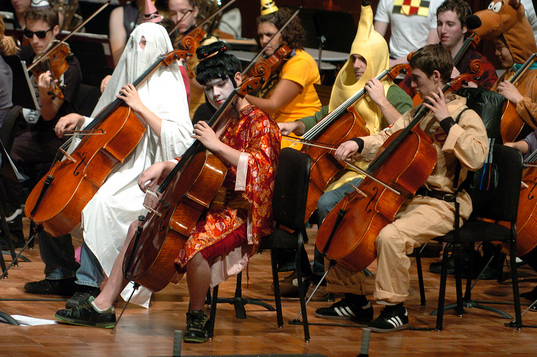I’ll be the first to admit I’m not the kind of person who can listen to recordings of classical music and muster up any kind of emotion whatsoever. If I try to use it to improve my concentration while I’m working on something, it only serves to distract me further. That being said, I absolutely love listening to orchestras play live. There is strength and passion in a live performance that never properly transfers into the CD or digital format.
The Venice Baroque Orchestra, who played at Hill Auditorium this past Wednesday night, was no letdown. They played both Vivaldi’s masterpiece The Four Seasons and Philip Glass’ interpretation of The Four Seasons, titled The American Four Seasons. I discovered at the end of the show that Philip Glass was actually in attendance to watch his work performed – he seemed overjoyed and perhaps a little overwhelmed by the group’s talent. The orchestra was a much smaller group than I’m used to seeing, consisting only of eighteen members. The lead violin, Robert McDuffie, also doubled as the conductor. There was no shortage of sound, however – the auditorium was full of their music. Most of the musicians stood for the entire performance (about an hour and a half, total). Although it looked exhausting, I liked the effect this had on the show – the lack of chairs gave the performers more freedom of movement on the stage. Their expressiveness, coupled with the movement of the music, built up the illusion that the performers were in constant, graceful dialogue with each other. It was a beautiful thing to watch.
The collection of instruments was interesting, too. There was a lute being played during the Vivaldi piece – I don’t think I’d ever seen one played outside of a Shakespeare production! That plus the harpsichord added a lot of dimension to the work. In Glass’ piece, they removed the harpsichord and lute, and added a keyboard. My initial reaction when I saw that being set up was trepidation, because I tend to associate keyboards with the ubiquitous synthesized pop music on our radios today. I was afraid the modern instrument would somehow cheapen the sound of the orchestra. As soon as they started playing, however, I was proven wrong. As it turned out, the only part of the concert I didn’t like were the songs in between movements of The American Four Seasons; the second one especially was too repetitive and grating. The movements themselves, though, were well done. It was sometimes hard to hear the relationship between Glass’ work and The Four Seasons, but the last two movements really brought that connection to the forefront. Glass’ music was unmistakably modern, but no less beautiful than Vivaldi’s.





